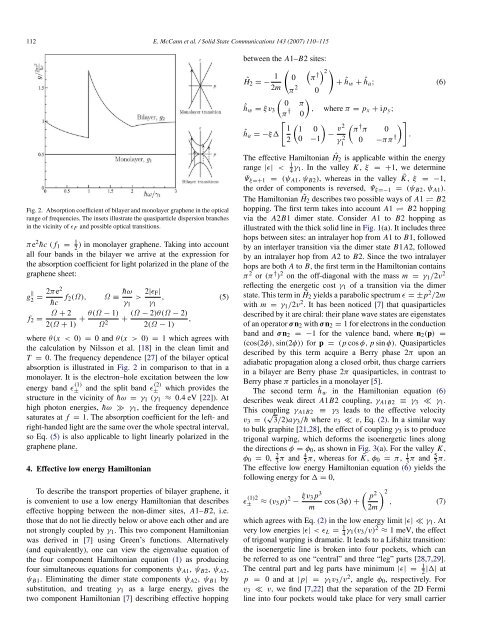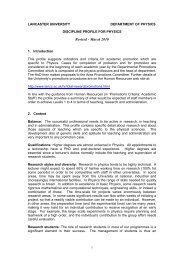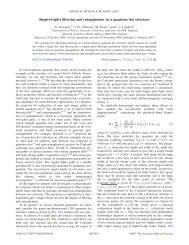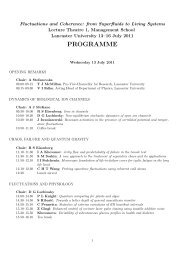Electrons in bilayer graphene - Physics at Lancaster University
Electrons in bilayer graphene - Physics at Lancaster University
Electrons in bilayer graphene - Physics at Lancaster University
You also want an ePaper? Increase the reach of your titles
YUMPU automatically turns print PDFs into web optimized ePapers that Google loves.
112 E. McCann et al. / Solid St<strong>at</strong>e Communic<strong>at</strong>ions 143 (2007) 110–115between the A1–B2 sites:(Ĥ 2 = − 1 0(π Ď) 2)+ ĥ w + ĥ a ; (6)2m π 2 0( ) 0 πĥ w = ξv 3π Ď , where π = p x + ip y ;0[ ( ) (1 1 0ĥ a = −ξ− v2 π Ď ) ] π 02 0 −1 0 −ππ Ď .γ 2 1Fig. 2. Absorption coefficient of <strong>bilayer</strong> and monolayer <strong>graphene</strong> <strong>in</strong> the opticalrange of frequencies. The <strong>in</strong>sets illustr<strong>at</strong>e the quasiparticle dispersion branches<strong>in</strong> the vic<strong>in</strong>ity of ɛ F and possible optical transitions.πe 2 ¯hc ( f 1 = 1 2) <strong>in</strong> monolayer <strong>graphene</strong>. Tak<strong>in</strong>g <strong>in</strong>to accountall four bands <strong>in</strong> the <strong>bilayer</strong> we arrive <strong>at</strong> the expression forthe absorption coefficient for light polarized <strong>in</strong> the plane of the<strong>graphene</strong> sheet:g ‖ 2 = 2πe2¯hc f 2(Ω), Ω ≡ ¯hωγ 1> 2|ɛ F|γ 1, (5)f 2 = Ω + 2 θ(Ω − 1)+2(Ω + 1) Ω 2 +(Ω − 2)θ(Ω − 2),2(Ω − 1)where θ(x < 0) = 0 and θ(x > 0) = 1 which agrees withthe calcul<strong>at</strong>ion by Nilsson et al. [18] <strong>in</strong> the clean limit andT = 0. The frequency dependence [27] of the <strong>bilayer</strong> opticalabsorption is illustr<strong>at</strong>ed <strong>in</strong> Fig. 2 <strong>in</strong> comparison to th<strong>at</strong> <strong>in</strong> amonolayer. It is the electron–hole excit<strong>at</strong>ion between the lowenergy band ɛ ± (1) and the split band ɛ(2) ± which provides thestructure <strong>in</strong> the vic<strong>in</strong>ity of ¯hω = γ 1 (γ 1 ≈ 0.4 eV [22]). Athigh photon energies, ¯hω ≫ γ 1 , the frequency dependences<strong>at</strong>ur<strong>at</strong>es <strong>at</strong> f = 1. The absorption coefficient for the left- andright-handed light are the same over the whole spectral <strong>in</strong>terval,so Eq. (5) is also applicable to light l<strong>in</strong>early polarized <strong>in</strong> the<strong>graphene</strong> plane.4. Effective low energy HamiltonianTo describe the transport properties of <strong>bilayer</strong> <strong>graphene</strong>, itis convenient to use a low energy Hamiltonian th<strong>at</strong> describeseffective hopp<strong>in</strong>g between the non-dimer sites, A1–B2, i.e.those th<strong>at</strong> do not lie directly below or above each other and arenot strongly coupled by γ 1 . This two component Hamiltonianwas derived <strong>in</strong> [7] us<strong>in</strong>g Green’s functions. Altern<strong>at</strong>ively(and equivalently), one can view the eigenvalue equ<strong>at</strong>ion ofthe four component Hamiltonian equ<strong>at</strong>ion (1) as produc<strong>in</strong>gfour simultaneous equ<strong>at</strong>ions for components ψ A1 , ψ B2 , ψ A2 ,ψ B1 . Elim<strong>in</strong><strong>at</strong><strong>in</strong>g the dimer st<strong>at</strong>e components ψ A2 , ψ B1 bysubstitution, and tre<strong>at</strong><strong>in</strong>g γ 1 as a large energy, gives thetwo component Hamiltonian [7] describ<strong>in</strong>g effective hopp<strong>in</strong>gThe effective Hamiltonian Ĥ 2 is applicable with<strong>in</strong> the energyrange |ɛ| < 1 4 γ 1. In the valley K , ξ = +1, we determ<strong>in</strong>eΨ ξ=+1 = (ψ A1 , ψ B2 ), whereas <strong>in</strong> the valley ˜K , ξ = −1,the order of components is reversed, Ψ ξ=−1 = (ψ B2 , ψ A1 ).The Hamiltonian Ĥ 2 describes two possible ways of A1 ⇋ B2hopp<strong>in</strong>g. The first term takes <strong>in</strong>to account A1 ⇋ B2 hopp<strong>in</strong>gvia the A2B1 dimer st<strong>at</strong>e. Consider A1 to B2 hopp<strong>in</strong>g asillustr<strong>at</strong>ed with the thick solid l<strong>in</strong>e <strong>in</strong> Fig. 1(a). It <strong>in</strong>cludes threehops between sites: an <strong>in</strong>tralayer hop from A1 to B1, followedby an <strong>in</strong>terlayer transition via the dimer st<strong>at</strong>e B1A2, followedby an <strong>in</strong>tralayer hop from A2 to B2. S<strong>in</strong>ce the two <strong>in</strong>tralayerhops are both A to B, the first term <strong>in</strong> the Hamiltonian conta<strong>in</strong>sπ 2 or (π Ď ) 2 on the off-diagonal with the mass m = γ 1 /2v 2reflect<strong>in</strong>g the energetic cost γ 1 of a transition via the dimerst<strong>at</strong>e. This term <strong>in</strong> Ĥ 2 yields a parabolic spectrum ɛ = ±p 2 /2mwith m = γ 1 /2v 2 . It has been noticed [7] th<strong>at</strong> quasiparticlesdescribed by it are chiral: their plane wave st<strong>at</strong>es are eigenst<strong>at</strong>esof an oper<strong>at</strong>or σ n 2 with σ n 2 = 1 for electrons <strong>in</strong> the conductionband and σ n 2 = −1 for the valence band, where n 2 (p) =(cos(2φ), s<strong>in</strong>(2φ)) for p = (p cos φ, p s<strong>in</strong> φ). Quasiparticlesdescribed by this term acquire a Berry phase 2π upon anadiab<strong>at</strong>ic propag<strong>at</strong>ion along a closed orbit, thus charge carriers<strong>in</strong> a <strong>bilayer</strong> are Berry phase 2π quasiparticles, <strong>in</strong> contrast toBerry phase π particles <strong>in</strong> a monolayer [5].The second term ĥ w <strong>in</strong> the Hamiltonian equ<strong>at</strong>ion (6)describes weak direct A1B2 coupl<strong>in</strong>g, γ A1B2 ≡ γ 3 ≪ γ 1 .This coupl<strong>in</strong>g γ A1B2 ≡ γ 3 leads to the effective velocityv 3 = ( √ 3/2)aγ 3 /¯h where v 3 ≪ v, Eq. (2). In a similar wayto bulk graphite [21,28], the effect of coupl<strong>in</strong>g γ 3 is to producetrigonal warp<strong>in</strong>g, which deforms the isoenergetic l<strong>in</strong>es alongthe directions φ = φ 0 , as shown <strong>in</strong> Fig. 3(a). For the valley K ,φ 0 = 0, 2 3 π and 4 3 π, whereas for ˜K , φ 0 = π, 1 3 π and 5 3 π.The effective low energy Hamiltonian equ<strong>at</strong>ion (6) yields thefollow<strong>in</strong>g energy for = 0,ɛ ± (1)2 ≈ (v 3 p) 2 − ξv 3 p 3 ( p2) 2m cos (3φ) + , (7)2mwhich agrees with Eq. (2) <strong>in</strong> the low energy limit |ɛ| ≪ γ 1 . Atvery low energies |ɛ| < ɛ L = 1 4 γ 1(v 3 /v) 2 ≈ 1 meV, the effectof trigonal warp<strong>in</strong>g is dram<strong>at</strong>ic. It leads to a Lifshitz transition:the isoenergetic l<strong>in</strong>e is broken <strong>in</strong>to four pockets, which canbe referred to as one “central” and three “leg” parts [28,7,29].The central part and leg parts have m<strong>in</strong>imum |ɛ| = 1 2|| <strong>at</strong>p = 0 and <strong>at</strong> |p| = γ 1 v 3 /v 2 , angle φ 0 , respectively. Forv 3 ≪ v, we f<strong>in</strong>d [7,22] th<strong>at</strong> the separ<strong>at</strong>ion of the 2D Fermil<strong>in</strong>e <strong>in</strong>to four pockets would take place for very small carrier















